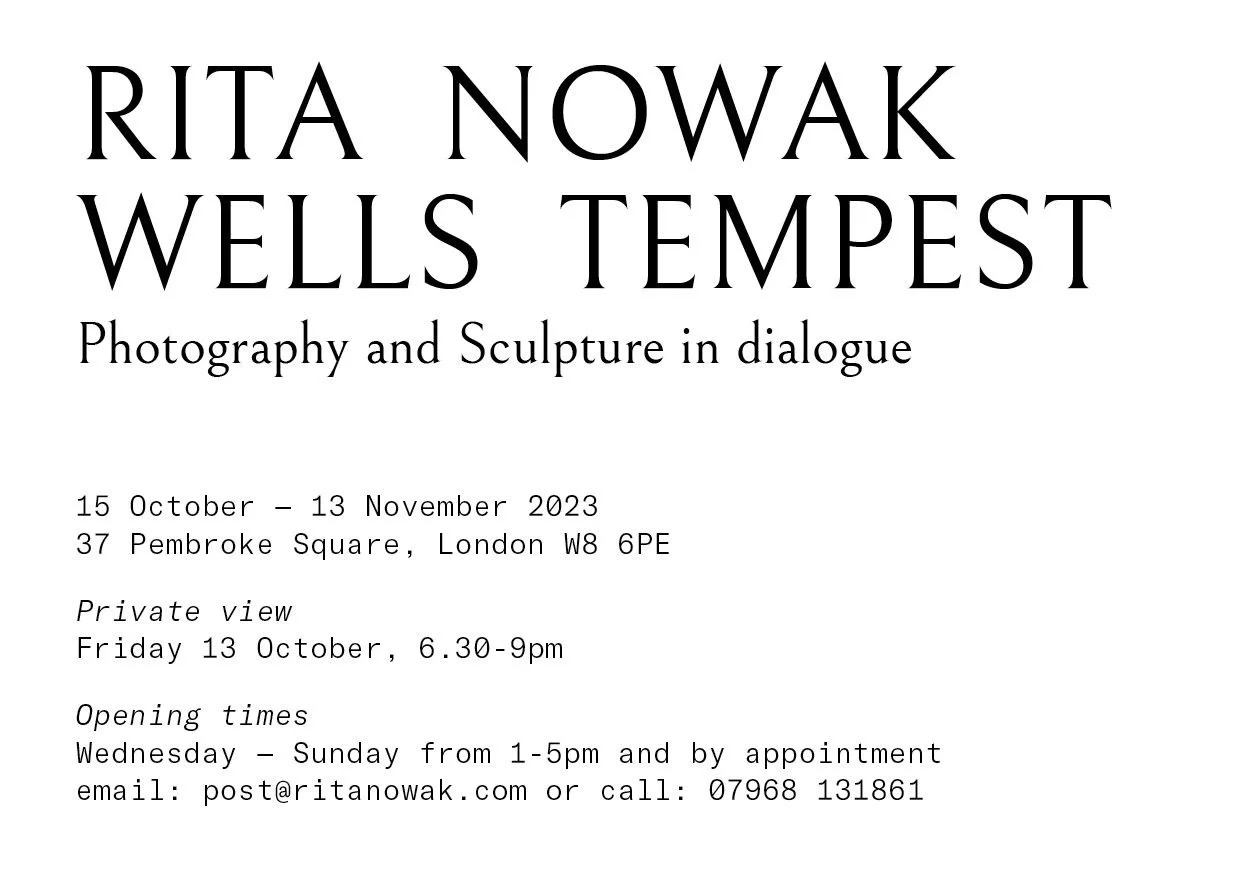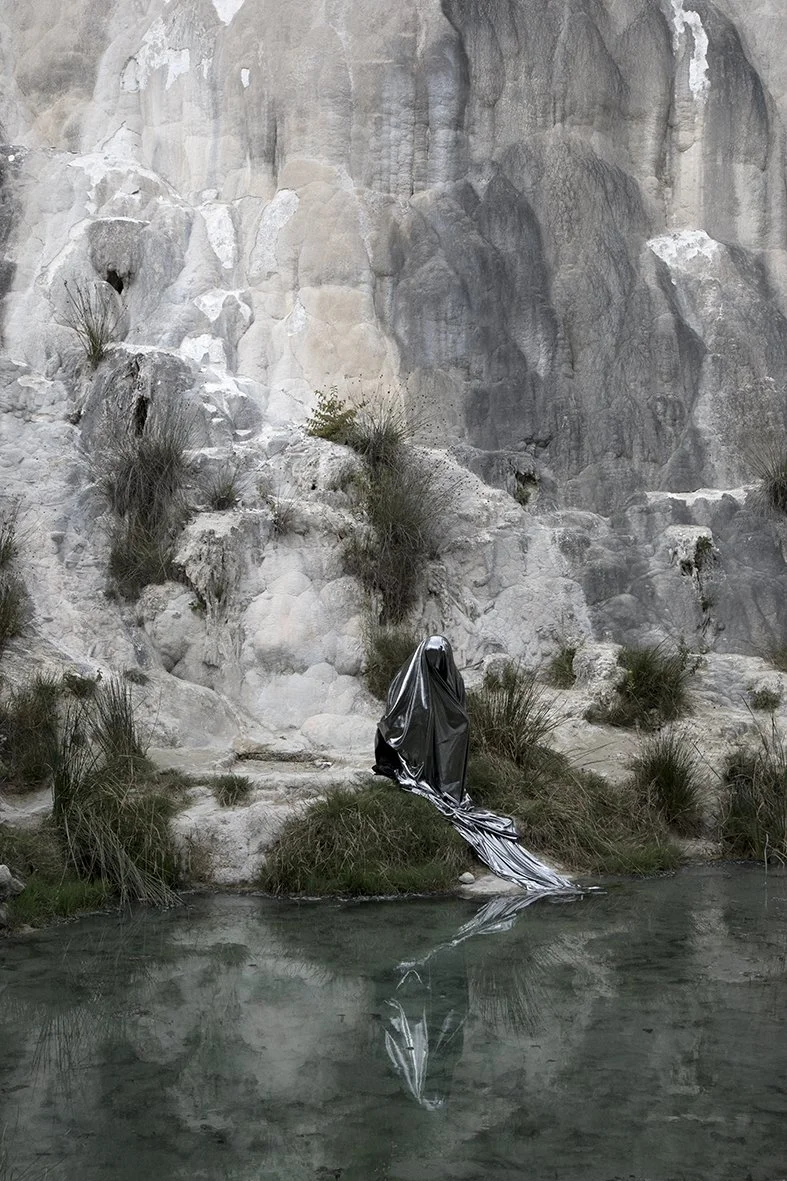
frame 44 October 2023
Wells Tempest and Rita Nowak in conversation
by Maude Martel
Wells Tempest is a British sculptor whose enigmatic wood and bronze pieces are influenced by nature, ancient cultures and mythology, particularly Egyptian and Meso-American.
Geometry and mathematic formulae are recurrent throughout his work, making use of naturally occuring geometric forms, vortices and the Fibonacci sequence.
Rita Nowak is an established Austrian artist working with staged photography. Her approach is painterly, occasionally referencing old masters such as Bosch, Goya and Manet.
Together, as a couple, they are showcasing their works in their new home. They spoke to Maude Martel about their new joint exhibition titled Photography and Sculpture in Dialogue, which opens to the public on the 15th October.

Maude Martel: How do you define your art style and how has it evolved over time?
Rita Nowak: I work with staged photography that is painterly in its composition and creation. Initially when I left art school in 2004 I created tableaux vivants (living pictures) –with direct references to old masters. Today these references fade into the background and establish an implicit art historical knowledge and reference.
Wells Tempest: My style is taken from a variety of artists and artistic movements that I admire and that have influenced me over the years. In my early teens, I was very taken with Cubism and Futurism; Picasso, Braque, Boccioni, along with Delaunay were big influences, as were Leger and le Corbusier. Later, I became interested in the Bauhaus school and Art Deco design and architecture.
MM: What themes or concepts do you frequently explore in your work?
RN: The subject is in confrontation with itself, the focus is always on people. At times it is purely about portraying the subject, but usually the protagonist 'embodies' something that can be generalized. The protagonist 'borrows' the viewer, allowing them to project their own emotion and sometimes also their absence.
WT: I am interested in ancient cultures, mythology, tribal art, nature and the cosmos. Most of my work combines elements of these themes, which recur frequently.
Wells Tempest & Rita Nowak, Sculpture & Photography in Dialogue is held at the artists' residence between 15th October - 13th November and accessible by appointment only.
MM: Are there recurring symbols or motifs in your work? If so, what do they represent?
RN: Absence of the other person. The encounter as the creation of a new, closed form. Often repressed, pushed aside or un-integrated aspects of human feeling are brought to light. This also explains the sometimes dark backgrounds, which help to brighten things up.
WT: One good example of this is the mathematic formula the Fibonacci sequence, which describes a spiral, with each number being the sum of the two that precede it. Spirals are found virtually everywhere in nature, from DNA, and romanesco fractals to weather systems, planetary motion and galaxies such as the Milky Way. They are inside us and we are surrounded by them. Spirals are recurrent throughout much of my work and feature prominently in this exhibition.
MM: Do you see a connection between your life experiences and your work?
RN: Yes, absolutely: the confrontation with the hidden and lost is definitely a biographical part of my life, the one theme that corresponds to my character traits is to turn to the figure itself. Not only does this strongly underlie the aesthetic of my pictures, but also my aesthetic thought process.
WT: I was fortunate enough to visit the Pyramids in Egypt when I was 12 years old. This experience had a profound effect on me; Seeing such huge megalithic structures and being able to enter the largest pyramid of Cheops and descend into the vast subterranean chamber beneath it was awe inspiring and has always held a fascination for me.
The main inspiration for the work in this exhibition is ancient Egyptian mythology. I have travelled to various ancient sites across the world, both east and west, from Angkor Wat in Cambodia to Tikal in Guatemala; each one provides fresh inspiration and ideas.
Rita Nowak, ANCIENT OF DAYS, 2021, Giclée Print, 150 x 100cm
MM: Who or what are your biggest artistic influences/inspirations?
RN: Strong artistic influences include Goya, William Blake, Tintoretto, James Ensor, Edvard Munch. Surrealists like Wolfgang Paalen and also contemporary artists like Glenn Brown and Sergej Bratkov. HP Lovecraft in literature.
WT: The artist I admire most is the Romanian sculptor Constantin Brancusi. His totemic sculpture, the ‘Bird in Space’, has been the single most influential work for me. It is fair to say that I might not have taken up sculpture if I hadn’t attempted to carve a facsimile of it.
Other sculptors such as Rodin, Moore, Epstein and Hepworth, particularly the latter two, have also been strong influences.
One artist who sits aside from these, for whom I have a particular admiration for, is H. R. Giger.
MM: Do you find that you inspire each other? Have you been influenced by each other's work?
RN: Our works are independent, but also related at the same time. In addition to an aesthetic that is certainly very close, our work is always preceded by intellectual, conceptual processes.
The concepts are always our own, we can support each other very strongly in terms of material, location or space: we speak the same language aesthetically, have a very similar sensitivity and a strong focus on what is underlying and the shape implied.
WT: I often assist Rita with her work and I am sometimes a physical prop, appearing in various pictures, mercifully covered up, usually by material, so that my identity is not revealed, but rather my body provides the outline or suggestion of a human shape. This always provides inspiration for me, as it allows me to play the part of a living sculpture and in turn gives me endless creative ideas.
MM: How do you decide when a sculpture is finished? Is there a particular feeling or moment that tells you it's complete?
WT: Some of my sculptures take a very long time to complete.
The most recent piece, ‘Kuiper Shard’, took more than 4 years. I tend to work on a few pieces at the same time, constantly moning back and forth from one to the other. I find it a much more satisfying working method, as carving, though very satisfying most of the time, can be monotonous and repetitive and it helps to put something aside when encountering problems, create some distance, then come back to it with fresh eyes. With pieces that are less detailed, it is fairly easy to know when they are nearing completion. Those which are more intricate or abstract, like Kuiper Shard for example, can appear to be finished one day, then after further inspection the following day, work will recommence and it will be months before it is completed.
MM: Do you each have a favourite piece or one that you are most proud of/that has a special meaning or significance to you?
RN: It's always what I've just realized that's closest to me/new works also tell me something new about myself and my art. Looking back, different images appeal to me more at different times, which then lead me down new paths.
WT: To date the piece that I am happiest with and most proud of is the bronze Ibis. This was originally carved from oak and it has singular importance, as it was only after finishing it, that I felt confident enough to pursue a career as a sculptor.
MM: What was the most challenging piece to create? How do you overcome challenges in your creative process?
RN: I find it difficult to answer this with regard to a particular work, it applies more to specific implementation processes. For example, in the past, it was a challenge to capture a person's absence as a visual idea. For a long time this was a challenge that was associated with a number of dead ends and wrong turns.
WT: Again it was the Ibis. Oak is a difficult wood to carve. It has an unforgiving grain and tends to split easily. There were many occasions when I thought it was too much of a challenge and very nearly gave up. However, I am stubborn and managed to stick with it. It taught me an important lesson: never to rush anything and to persevere when problems arise; there are always solutions if you have the patience to find them.
MM: Do you have similar preoccupations, as far as your work goes?
WT: Within art, definitely. Our enthusiasm is for the hidden, the quiet and the constant far more than for the ironic, the cynical and loud.
MM: When/how did the idea for this exhibition come about?
RN: The idea of an empty house inspired us to show our art together on this ‘tabula rasa’. From this space of no more and not yet, we expect an atmosphere in which our works will be particularly effective.
MM: What is the advantage of having the show in a private house rather than a gallery?
WT: In our opinion, this intimate space of emptiness fits very well with the aesthetics and message of our work.
Wells Tempest, KUIPER SHARD, 2023, walnut maquette for bronze cast, 74 x 14cm x 6cm
MM: What are your future artistic aspirations?
RN: Experiment with other media. More work. More exposure.
WT: I would like to have a solo show in London next year. With regard to the work itself I plan to experiment with other mediums, such as clay, stone and marble.
MM: Do you have any advice for aspiring artists?
RN: Quote Tarkovskij: The only thing an artist can do to be understood is to be sincere.
WT: Always experiment and do not be afraid to show the influence of artists one admires in your own work.




